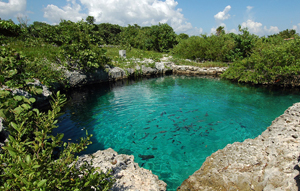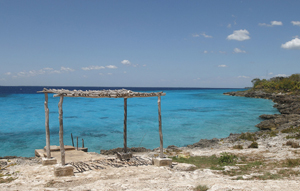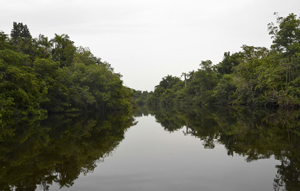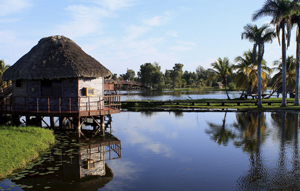Excursions in La Ciénaga de Zapata, Cuba.
Caleta Buena
Caleta Buena is an unforgettable place, located 8 km from Playa Giron, at the end of the Cienaga de Zapata, at the south cost of Cuba. Caleta Buena is an exclusive attraction of Playa Giron and unknown diving and snorkeling destination in Cuba. The area holds 10 diving sites, where corsairs and pirates arrived centuries ago and where visitors can enjoy crystal clear water and large variety of tropical fish.
Punta Perdiz
Punta Perdiz is a place of great endemism and high degree of conservation, which inserts the Bay of Pigs, with significant ecological stability and spectacular karst manifestations. There is great coral reserve, seabed lush beauty and water with pleasant temperatures at any time of year where you can dive into the open sea or go diving in flooded caves brackish water areas linked to the cave-system of the Cienaga de Zapata for this purpose they have a highly qualified staff. The dive center has the conditions for dips in accordance with established rules for that sport in the world. This area is declared protected area is highlighted by a preserved fauna and flora and diverse, located in the Cienaga de Zapata National Park Biosphere Reserve. Punta Perdiz also offers visitors numerous services and namesake restaurant, very attractive because of its design that simulates a ship, offers catering service mode buffet and open bar.
Crocodile Hatchery
It is an area of extraordinary ecological value, both for the variety of fauna, with some fish considered living fossils , such as Manjuarí , a variety of reptiles, including crocodiles , which are in clear recovery thanks to the hatcheries, as being rather wintering of migratory birds from North America. Such is its importance in the preservation of nature, which is a RAMSAR site since 2000 and is considered a Biosphere Reserve by UNESCO.
River Hatiguanico
This river is considered the most important and connotation in the territory, given by the water supply provided by the underground drainage of numerous springs that flow through “hydrogeological windows” . Born into a huge source of fresh and clear water. Species such as tarpon ( shad) and snook ( snook ) are characteristic of this area. They are also Manatí, gar and other species.
In its course fishing it is done from the boat and recommended techniques are fly and spinning, although the trolling can give results. Where important populations ( Manatí ) Trichechus manatus and other species of great conservation value are reported .
This river is considered the most important and connotation in the territory, given by the water supply provided by the underground drainage of numerous springs that flow through “hydrogeological windows” . Born into a huge source of fresh and clear water. Species such as tarpon ( shad) and snook ( snook ) are characteristic of this area. They are also Manatí, gar and other species.
In its course fishing it is done from the boat and recommended techniques are fly and spinning, although the trolling can give results. Where important populations ( Manatí ) Trichechus manatus and other species of great conservation value are reported .
Laguna del Tesoro
Legend has it that owes its name to a passage dated makes some hundreds of years: the Indians who settled in their surroundings, feeling threatened by the excesses of the conquerors, they threw into the lake its most precious riches and treasures with to prevent them from falling into the hands of those .
It is located in the Guama Resort in Laguna del Tesoro. It is a replica of a Taino village of ancient natives of Cuba , consists of a set of 25 sculptures full-scale sculpted by the renowned Cuban sculptor Rita Longa , and besides, there are four huts on land and a hut – typical houses of the Cuban natives . Some of its inhabitants are artificial Dayamí , the young dreamer ; Abey , the great crocodile hunter ; Cajimo hunter jutías ; Maguanay , mother who prepares cassava bread ; Yaima , a child playing ; and among all the Cacique Guama .
Museum Playa Girón
Simple style, was built at the end of 1959. From 1964 to 1976 his two salons exhibited an allegorical photographic exhibition to actions and response of the Cuban people about the bad intentions of mercenary forces that sought to annihilate the nascent Cuban Revolution.
Subsequently, the property is expanded and reopened, in the Municipal Museum on 19 April 1976. The Museum is dedicated primarily to highlight actions to April 1961.
It is an eloquent example of how the National Revolutionary Militias Liberation Army, Revolutionary National Police and Revolutionary Navy, along with the effective performance of a small air force, wiped out just in 65 hours at the well-equipped mercenary force, sent by the rulers US.
Its functions rescue, conservation, hoarding, transient exposure and dissemination, are also aimed at the history of the town. Among the most important activities carried out they are: the sample of the month, talks, talks, lectures, meetings with history, treatment of the most important anniversaries of each month, giving courses for adults and interest circles.
[dopbsp id=”143″ lang=”es”]
What more could you want?
La Ciénaga de Zapata has interest as holiday destination, in first term, for the lovers of the nature tourism: observation of birds, hiking, ecotourism; but there is also space for the lovers of the diving, of the adventure tourism, of the sport fishing and of the enjoyment of beaches, and even for the interested ones in the recent history of the island.
Central de Reservas
Calle Velazquez, 53
28001 – Madrid – España
reservas@lacienagadezapata.com
+34 666 979 375
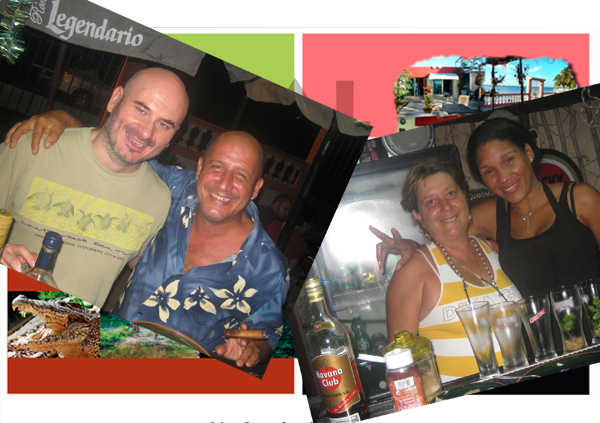
Esta entrada también está disponible en: Spanish



